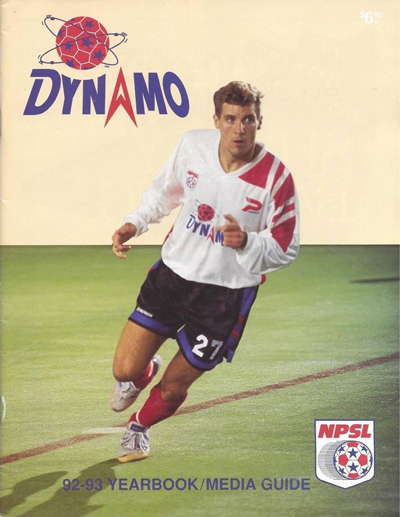American Indoor Soccer Association (1988-1990)
National Professional Soccer League (1990-1995)
Tombstone
Born: January 6, 1988 – AISA expansion franchise
Move Announced: March 1995 (Cincinnati Silverbacks)
First Game: February 17, 1988 (L 3-2 vs. Jacksonville Generals)
Last Game: March 25, 1995 (L 20-4 @ Harrisburg Heat)
AISA/NPSL Championships: None
Arenas
1988-1990: Hara Arena (5,600)11989-90 Hershey Impact Program
Opened: 1964
Demolished: 2020-2021
1990-1993: Ervin J. Nutter Center (9,000)
Opened: 1990
1993-1995: Dayton Convention Center
Opened: 1973
Marketing
Team Colors: Red, White & Royal Blue
Ownership
Owners:
- 1988-1991: Jerry Butcher
- 1991-1995: Richard Chernesky, Edward Kress, et al.
Trophy Case
AISA Coach of the Year
- 1989-90: Rick Schweizer
Background
The Dayton Dynamo were an indoor soccer club that played seven winter seasons in Western Ohio.
Founder Jerry Butcher, 38, was the former soccer coach at the University of Dayton and owner of the Englewood Indoor Soccer center. In January 1988, Butcher formed the Dayton Dynamo and entered his club in the foundering American Indoor Soccer Association. The AISA barely limped into the 1987-88 season after losing four of its eight clubs during the previous offseason. After playing a shortened regular season schedule, the league replaced its playoffs with something called “the Challenge Cup”. The six-team tournament series included the league’s four active clubs in Canton, Fort Wayne, Memphis and Milwaukee, plus two expansion candidates on probation: the Jacksonville Generals and Butcher’s Dayton Dynamo.
The Dynamo acquitted themselves reasonably well in the Challenge Cup in February 1988. Butcher financed the team alone to the tune of about $100,000. Without any real promotion or staff, the team managed to average 2,685 fans at Hara Arena for six Challenge Cup home dates.
Jacksonville soon fell by the wayside, but Butcher pushed forward and applied for full membership in the AISA for the 1988-89 season. The Dynamo were formally admitted to the league on July 9, 1988.
Early Success
Butcher stocked the Dynamo with primarily American-born players. The 1988-89 season was a struggle, as the Dynamo finished tied for last place with a 14-26 record.
But the Dynamo would advance to the league championship series in both their second and third seasons. The Canton Invaders defeated Dayton 3 games to 1 in the 1990 AISA championship series. Rick Schweizer was named the league’s Coach-of-the-Year. By 1990 the AISA was back up to nine teams and in growth mode once again. The league re-branded itself as the National Professional Soccer League (NPSL) for the 1990-91 season. The Dynamo returned to the finals for a second straight season, but were swept by the Chicago Power in three games.
Arena Hopping
The Dynamo played their first two seasons at Hara Arena. In 1990 the club moved to the new 9,000-seat Nutter Center on the campus of Wright State University.
By the dawn of the Dynamo’s fourth season in the late autumn of 1991, owner Jerry Butcher was financially exhausted. A small business owner, Butcher had never succeeded in bring in deep pocketed owners to help fund the Dynamo. In December 1991, broke and approximately half a million dollars in debt, Butcher filed for Chapter 11 bankruptcy. The NPSL took over operations of the Dynamo just before Christmas. Days later, a pair of local attorneys, Richard Chernesky and Edward Kress, stepped forward to save the Dynamo for Dayton. Chernesky & Kress eventually put together a 21-person limited partnership to back the team, cobbling the investor group that Butcher was never able to engineer.
Prior to the 1993-94 season, the Dynamo moved out of the Nutter Center and the 4,600-seat Dayton Convention Center. The team was allowed to play rent-free at the Convention Center as part of a civic effort to try and revitalize downtown Dayton. But none of the Dynamo’s various arena moves did much to move the needle on attendance, which stubbornly held around 3,000 fans per match for most of the team’s existence.
Demise
The Dynamo’s on-field performance weakened after the back-to-back Finals appearances in 1990 and 1991. The club missed the playoffs in each of it final four seasons.
As early as 1993, Dynamo officials began making noises about a possible move an hour south to Cincinnati. After two mediocre seasons at the Convention Center, the Cincinnati rumors were finally confirmed in March of 1995. The operators of the very popular Cincinnati Cyclones minor league hockey team purchased the Dynamo and re-branded the club as the Cincinnati Silverbacks for the 1995-96 NPSL season. The franchise played on for three seasons in the Queen City before finally going out of business in 1998.
Dayton Dynamo Shop
[auction-nudge tool=”listings”]
Links
##

